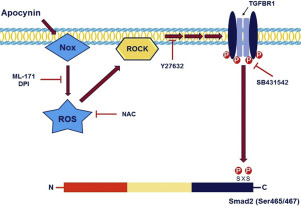Biochimica et Biophysica Acta (BBA) - General Subjects ( IF 2.8 ) Pub Date : 2019-10-30 , DOI: 10.1016/j.bbagen.2019.129463 Raafat Mohamed 1 , Yingnan Cao 2 , Rizwana Afroz 1 , Suowen Xu 3 , Hang T Ta 4 , Michael Barras 1 , Wenhua Zheng 5 , Peter J Little 6 , Danielle Kamato 6

|
Background
Widely used NAPDH oxidase (Nox) inhibitor, apocynin is a prodrug that needs to be converted to its pharmacologically active form by myeloperoxidase. In myeloperoxidase deficient non phagocytic cells such as vascular smooth muscle cells (VSMCs) apocynin stimulates the production of ROS. ROS is generated by the activation of many signalling pathways, thus we have used apocynin as a pharmacological tool to characterise the role of endogenous ROS in activating the transforming growth factor beta receptor (TGFBR1) without the activation of other pathways.
Methods
The in vitro study utilized human VSMCs. Western blotting and quantitative real time PCR were performed to assess signalling pathways and gene expression, respectively. Intracellular ROS levels was measured using fluorescence detection assay.
Results
Treatment with apocynin of human VSMCs stimulated ROS production and the phosphorylation of TGFBR1 and subsequent activation of TGFBR1 signalling leading to the formation of phosphorylated Smad2 which consequently upregulates the mRNA expression of glycosaminoglycan synthesizing enzyme.
Conclusions
These findings outline a specific involvement of ROS production in TGFBR1 activation. Furthermore, because apocynin stimulates Nox and ROS production, apocynin must be used with considerable care in vitro as its actions clearly extend beyond the stimulation of Nox enzymes and it has consequences for cellular signalling.
General significance
Apocynin can stimulate Nox leading to the production of ROS and the outcome is completely dependent upon the redox properties of the cell.
中文翻译:

ROS直接激活人血管平滑肌细胞中的转化生长因子β1型受体信号传导。
背景
载脂蛋白是广泛使用的NAPDH氧化酶(Nox)抑制剂,需要通过髓过氧化物酶将其转化为药理活性形式。在缺乏髓过氧化物酶的非吞噬细胞中,如血管平滑肌细胞(VSMC),载脂蛋白A可以刺激ROS的产生。ROS是由许多信号通路的激活所产生的,因此我们已经使用了Apocynin作为药理学工具来表征内源性ROS在激活转化生长因子β受体(TGFBR1)而没有激活其他通路的过程中的作用。
方法
体外研究利用人VSMC。分别进行了蛋白质印迹和定量实时PCR来评估信号通路和基因表达。使用荧光检测测定法测量细胞内ROS水平。
结果
用Apocynin处理人VSMC刺激了ROS的产生和TGFBR1的磷酸化以及随后TGFBR1信号的激活,导致磷酸化的Smad2的形成,从而上调了糖胺聚糖合成酶的mRNA表达。
结论
这些发现概述了ROS产生与TGFBR1激活的特定关系。此外,由于载脂蛋白刺激了Nox和ROS的产生,因此载脂蛋白在体外的作用明显超出了Nox酶的刺激范围,并且对细胞信号传导具有影响,因此必须在体外谨慎使用。
一般意义
Apocynin可以刺激Nox导致ROS的产生,其结果完全取决于细胞的氧化还原特性。











































 京公网安备 11010802027423号
京公网安备 11010802027423号